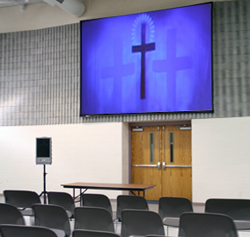When thinking of a church, most people conjure images of a building with chairs or pews, carpet on the floor, maybe some stained glass. The loudspeakers hang in a cluster near the front and there’s a sound booth in the back. Down the hallway are the nursery and the church office.
While that describes the majority of churches, a growing number of churches are forming that don’t fit that description at all.
Churches that do not own a building are becoming more common, renting a building for Sunday mornings and maybe for Wednesday nights. Once strictly the domain of churches just getting started (called “church plants”), more established churches are choosing not to be burdened with the upkeep and expense of a large facility.
A Church With Vision
Bruce Sanders has been the pastor of Capital Vision Christian Church in Olympia, WA since he founded it several years ago. On Sundays at 9 am, he arrives at Olympia High School’s performing arts auditorium an hour and a half before the service is scheduled to begin.
Meanwhile, Jason Inman and his crew of three volunteers arrive around 8:30 am to load in sound equipment, band instruments and Sunday School supplies. They set out several sandwich-board signs on the streets nearby, announcing the service.
On Sunday mornings in Olympia, more than a dozen churches gather in various rented spaces, including schools, gymnasiums, cafeterias, classrooms, performance halls, community centers, hotel banquet rooms and even other churches. Where climate permits, some even hold their services outdoors in parks or natural amphitheaters.
Portable Quality
But just because they meet in temporary space does not mean that these churches don’t value a high-quality sound system, with many offering contemporary services, often centered on a guitar-driven pop- or rock-flavored band.
After Jason and his team set up the system at Capital Vision, one of the crew, often a teenage volunteer, steps behind the mixer while Jason straps on a Taylor acoustic guitar and begins sound check.
Behind him are bass guitar, piano, two keyboards, several backup singers and a drum set. Off to the side, a portable screen is set up, and the computer operator checks the video projector that displays the song lyrics and sermon notes. Other than the school’s piano, all equipment is set up and torn down every weekend.
When 10:30 rolls around, Jason greets the crowd and invites them to stand up and sing with him. Then the band starts into their set, and the next 30 to 40 minutes are essentially a 90 dB contemporary Christian music concert.
Jason finishes the set with a prayer, perhaps with a little keyboard or guitar in the background. Then an emcee gets up and makes introductions and delivers announcements before Pastor Sanders gets up to teach.
A Contemporary Vibe
More like a seminar speaker than a traditional pulpit preacher, Sanders walks around the stage with a wireless lavalier microphone clipped to his open collar. He talks with the congregation, stopping every so often to tell a joke or refer to a current news headline.
The video projector shows an outline of his sermon, interspersed with photos and video clips to support the message. By noon, the congregation is drinking coffee and eating cookies in the foyer, talking about the sermon and other things, like the Seattle Seahawks.
I deal with dozens of churches like Capital Vision, and there are thousands more forming around the country. Several of my clients are just starting, with maybe 40 to 50 people in the congregation, while others have a few hundred members who meet twice a week. A small number are quite large; one portable church has several thousand people meeting in each of three services in a rented high school every Sunday morning, with a band and sound system that is second to none.
There isn’t really a standard sound system for a portable church, because there really isn’t a standard church. However, a sound system for a portable church is not the same as a sound system for a band. There are quite a few components in common, but the goals are markedly different.




















